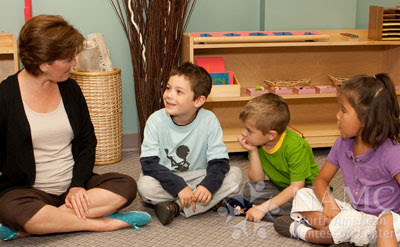 |
| Promote a successful start to the year by offering Montessori students a balance between circle time and work periods in the first few days |
“It was chaos. The older students just wanted to work and I couldn’t get them to sit in circle for very long. They wanted to get the materials out right away. And when I got them to circle, they acted silly and unruly.”
Do Rules and Routines Have a Place in the Montessori Elementary Classroom?
Maria Montessori believed that children were capable of great periods of concentration and focus. She insisted on a 3-hour work cycle so that children could maximize their attention on their work without distraction. She advocated that in order to develop their attention span, children need the freedom to choose the work that interests them. It is not the teacher who tells the children what to work on but the children who tell the teacher. Knowing this, I can see where both the teacher and the children were frustrated by the plan to sit in circle all morning. A child who is deeply focused and concentrating on work that interests him has a much greater attention span than the child who is forced to just sit and listen.
So, what is the best way to introduce children to the routine of the Montessori environment? Do it incrementally, allowing children to work in between times of talking.
- Have older, experienced children at the door with you as greeters. When a younger or new child enters, invite an older child to show her/him where they hang their jackets and put their lunches, and to give him/her a basic tour around the room. Then, encourage them to choose a book together and read quietly on the line for morning circle.
- When everyone has arrived, begin the morning circle as you would a regular morning. Talk about the weather, work with the calendar, sing a song. You may also choose to play a quick “get-to-know-you” game. And then, excuse the older children to go work. They will be happy to get busy! They have had the whole summer off and are ready to work.
- Now you are left with the new children. Here you can have small group presentations such as:
- How to roll and unroll a rug
- How to walk around a rug
- How to choose a work
- How to remove and replace a work from the shelf
- How to prepare a snack
- You can also walk through of the classroom, noting the different areas and examining the works. Then, let the new children get to work, too! After seeing the beautiful materials and watching the older children work, they will be happy to get the chance. This is where entry level materials come in handy. They will not need lessons on works they already know. Be sure to have something that children who are new to Montessori can work with, too!
- That afternoon, you can come back together as a whole class and talk about what the children think the class rules should be. Brainstorm together, recording all ideas. Then, ask them to categorize the items. Can it be narrowed down? Are there duplicates? Keep whittling down the list. Someone is bound to have that “Aha!” moment and say, “Why don’t we just say ‘treat others the way we would like to be treated’?” What a wonderful way to make a very good, precise rule without a whole list to worry about.
As much as possible, NAMC’s web blog reflects the Montessori curriculum as provided in its teacher training programs. We realize and respect that Montessori schools are unique and may vary their schedules and offerings in accordance with the needs of their individual communities. We hope that our readers will find our articles useful and inspiring as a contribution to the global Montessori community.
© North American Montessori Center - originally posted in its entirety at Montessori Teacher Training on Monday, September 10, 2012.
© North American Montessori Center - originally posted in its entirety at Montessori Teacher Training on Monday, September 10, 2012.

9 children...how many teachers on a outing to the Park?
ReplyDelete